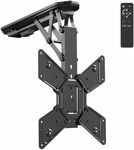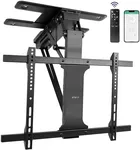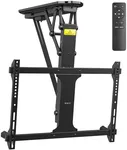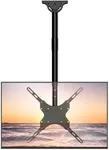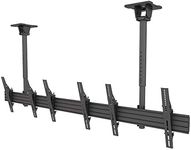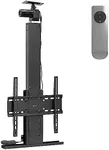Buying Guide for the Best Ceiling TV Mounts
Choosing the right ceiling TV mount is important to ensure your television is safely and securely installed, while also providing the best viewing experience for your space. Before making a decision, think about where you want to place your TV, the size and weight of your television, and how you want to be able to adjust or move the screen. Understanding the key features of ceiling TV mounts will help you find a model that fits your needs and your room layout.Weight CapacityWeight capacity refers to the maximum weight the ceiling mount can safely support. This is crucial because using a mount that can't handle your TV's weight can be dangerous and may result in damage or injury. Ceiling mounts are usually divided into ranges like light-duty (up to 40 lbs), medium-duty (40-80 lbs), and heavy-duty (over 80 lbs). To pick the right one, check your TV's weight (including any accessories) and choose a mount that can support at least that much, ideally with some extra margin for safety.
VESA CompatibilityVESA compatibility refers to the pattern of holes on the back of your TV used for mounting. This is important because the mount and your TV need to match in order to fit together. VESA patterns are measured in millimeters, such as 200x200, 400x400, or 600x400. To navigate this, check your TV's manual or the back of your TV for the VESA size, and make sure the mount supports that pattern. Picking the right one is simple: just match your TV's VESA size to the mount's supported sizes.
Adjustability (Tilt, Swivel, Rotation)Adjustability describes how much you can move or angle the TV once it's mounted. This is important for getting the best viewing angle and reducing glare. Some mounts are fixed, while others allow tilting up and down, swiveling side to side, or even rotating the screen. Fixed mounts are best for situations where the viewing position never changes, while adjustable mounts are great for rooms where you might watch from different spots or need to angle the TV for comfort. Think about how you'll use the TV and choose a mount with the right level of adjustability for your needs.
Drop Length (Pole Length)Drop length, or pole length, is the distance from the ceiling to the TV. This matters because it affects the viewing height and how the TV fits into your room. Mounts come with fixed or adjustable pole lengths, usually ranging from a few inches to several feet. For high ceilings, you'll need a longer drop to bring the TV to eye level, while for standard ceilings, a shorter drop is usually enough. Measure your ceiling height and decide where you want the TV to sit, then pick a mount with a suitable drop length.
Cable ManagementCable management refers to features that help hide or organize the wires running to your TV. This is important for a clean, tidy look and to prevent cables from dangling or getting damaged. Some mounts have built-in channels or clips for cables, while others leave them exposed. If you care about appearance or safety, look for a mount with good cable management options. Consider how many devices you'll connect and how you want the cables to run when making your choice.
Installation FlexibilityInstallation flexibility means how easily the mount can be installed in different ceiling types, such as flat, sloped, or vaulted ceilings. This is important because not all mounts work with every ceiling style. Some mounts are designed for flat ceilings only, while others have adjustable brackets for angled ceilings. Before buying, check your ceiling type and make sure the mount is compatible. If your ceiling is unusual, look for a mount that specifically mentions support for that style.


